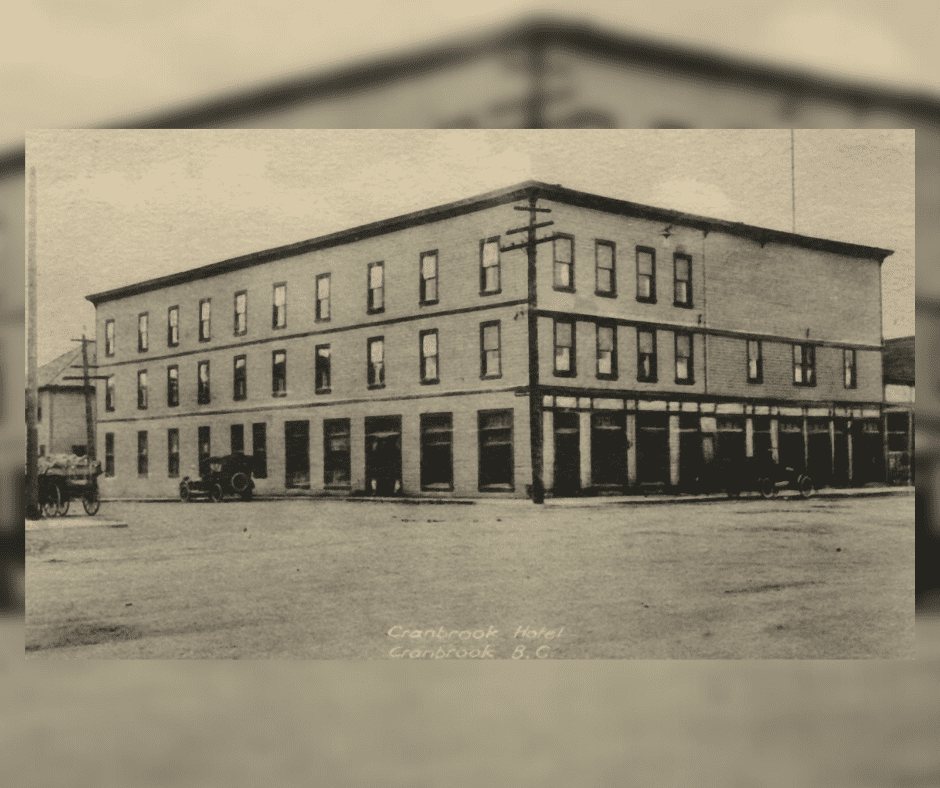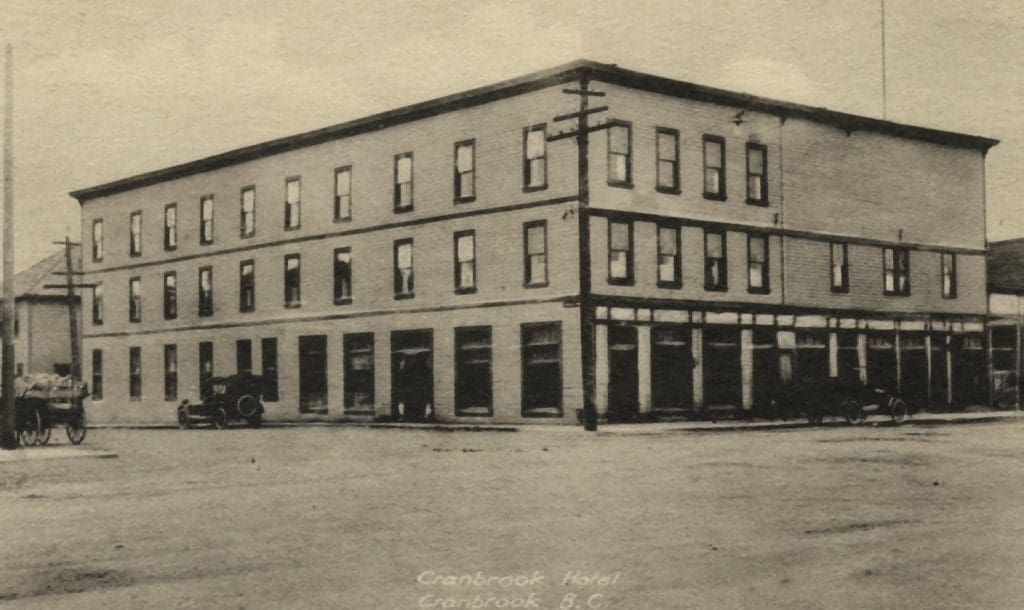
Cranbrook’s First Lady: A Brief History of the Cranbrook Hotel
By Emily Russell
The Cranbrook Hotel has been a part of our cityscape since 1897. The significance of this building can best be described with a quote from the Cranbrook Harold and Courier, “Probably the first sticks of lumber went into the Framing of the Cranbrook Hotel.” The hotel was one of the first buildings erected in the area. The Cranbrook Hotel defined the city that we know today, and the people who passed through her doors helped write our history. This is how the hotel got its nickname as the “First Lady” of Cranbrook.
The construction of the Cranbrook Hotel was commissioned by Colonel Baker. At the time, the only other settler structure in the area was the Baker Estate. The Baker Estate retained ownership of the hotel and outsource management to more knowledgeable folks. The first people to have managed the Cranbrook Hotel was Angus Morrison and James Ryan. Without people, a building is just a building. The folks who worked, visited, and built the hotel are the reason the structure is has a story to tell.

17 in x 22 in
CBK.2017.032.039
Angus came into this position first and would bring James on to help run the hotel before it opened. The hotel was declared open for business on December 23, 1897. Two days later, they hosted the first Christmas dinner in Cranbrook. The duo had already made a name for themselves in the Kootenays which helped bring in business, however, it was the arrival of the Canadian Pacific Railway in 1898 that made business flourish. Countless government officials, railway executives, travelers, and celebrities stayed in the Cranbrook Hotel while it was under their management. Alas, all good things must come to an end. Their partnership would last only until 1903. Angus sold his interest to George Hogarth to pursue a career as a farmer. Angus proved to be as talented a farmer as he was a hotel manager. He and his wife served their community by supplying milk and butter until they retired in 1951.
James Ryan was a wealthy and popular man, which contributed to his success. James and George decided to move the building to the back of the lot in 1904. That same year, James Ryan sold his interest to George Hogarth and Victor Rollins to pursue other ventures and a political career.
Both George and Victor were well versed in the art of hotel management. Their popularity and name recognition benefitted them greatly in Cranbrook and helped them thrive financially. George Hogarth would become the sole proprietor of the Cranbrook Hotel by 1918, running the business by himself until his passing in 1924. George’s wife Nellie Hogarth, and their two sons Tom and Eneas, assumed responsibility for the hotel after George’s death. The trio managed the hotel together until 1943. Tom and Nellie Hogarth sold their shares to Eneas. He ran the hotel solo until his passing in 1951. After his death, his wife Ila Hogarth and her brother, Dick Slye, would take ownership of the hotel. Dick Slye brought on Jack Barber in 1952. The two had a successful partnership for over a decade. In 1964, Jack Barber retired. It was not long before Dick Slye would join Jack in retirement. Since 1970, the hotel passed through a few more hands but, our First Lady does not seem to be going anywhere anytime soon.

CBK.1990.085.001.013
As Cranbrook continued to grow, the Cranbrook Hotel stood as a physical reminder of the city’s success. The original building was two stories tall with a false wall to the west to make the building appear more impressive. In 1907, contractor D.J Johnson completed the third floor for George and Victor, the renovation was met with high praise from the media and the town. The hotel occupies 10,000 square feet and was originally built with wood, later it was rebuilt with brick and mortar, a notably more fire-resistant material. Our First Lady has proven herself to be a sturdy and resilient building. Fire has been an issue in Cranbrook since the early 1900s. Shortly after the hotel was moved in 1904, a fire broke out and overwhelmed the back of the building. Tragedy struck at 2 am on July 24th, 1936, when another fire broke out. Most of the 100 block of Baker Street was up in flames by the time the fire department arrived. Among the buildings affected, the hotel sustained about $30,000 in damages, destroying most of the room located on the back of the lot. The Hogarth’s did not let the fire get to them. In fact, they took this as an opportunity to make improvements. The Cranbrook Hotel has survived several fires over the past century however, none of them have been able to take down Cranbrook’s First Lady.

18 cm x 13 cm
CBK.1976.062.002
The Cranbrook Hotel has been a foundational part of our city for over a century. She gave us our first Christmas Dinner and helped define our community’s identity as a determined and resilient people. Propelled by the prosperity of rail travel, the hotel became an emblem of success. Our First Lady tells a story of strength having survived two world wars, the great depression, and modern economic turmoil. The legacy and the building continue to live on as an important part of our history.
Sources:
Cameron, Jim. “The Cranbrook Hotel.” In Cranbrook Then and Now, Vol. 1. 6-7. Cranbrook:, BC Janus, 2015.
Cranbrook Herald and Courier. “Businesses and Recollections of Businesses: The Cranbrook Hotel.” In Cranbrook and District: Key City Chronicles 1898-, 174-175. Fort Steel: Cranbrook & District Key City Chronicles, 2002.